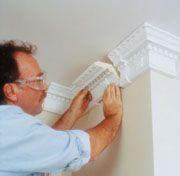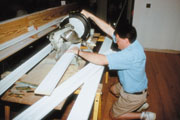

While wood trims are widely available and have a good aesthetic value, they have several disadvantages. Susceptible to decay, rot and warping in a variety of climates, wood millwork can become infested with termites. And, although wood offers warmth and beauty to a project, it requires stripping, repainting and intense maintenance.
Currently available in thousands of profiles from a variety of manufacturers, urethane millwork products have been applauded for their ease of installation and low-maintenance features. An intricate decorative crown molding, which could take days to construct from wood, can now be manufactured as a single piece of urethane—and installed in minutes.
Naturally resistant to decay, splintering and insect infestation, urethane products have a closed-cell structure that prevents water penetration and absorption. That makes them ideal for all types of climates; from areas in extreme cold temperatures and harsh weather to those receiving an abundance of rain, salt spray and searing temperatures. More importantly, it makes the product durable for all types of interior situations also—from the high-humidity areas of the bathroom and kitchen to the sometimes less-insulated basement areas. Urethane millwork pieces adapt perfectly to all types of interior wall and ceiling environments.
One of the chief assets of urethane is its ability to gain highly detailed, authentic looking reproductions of historic products. A heavy, ornate plaster ceiling medallion can easily be replicated in a urethane piece weighing under a pound. Some manufacturers have developed a two-piece interlocking ceiling medallion. Available in different decorative profiles, the two pieces fit together snugly around the cap of a lighting fixture or ceiling fan. There is no need for disconnecting electrical wiring, removing fixtures, putting up the medallion and then reconnecting all the features. With the two-piece medallion, installation should take less than 20 minutes, and seams in the medallion are perfectly covered with caulking and paint.
Overall, compared to wood, plaster and concrete decorative trim products, urethane millwork generally has lower product and installation costs. The low-maintenance aspects of urethane millwork, coupled with the product’s resistance to water and insect infestation, helps the product continue to grow in popularity.
Decorative beauty
Urethane companies offer authentic architectural profiles from uncluttered simplicity to extremely ornate designs. Ideal for both interior and exterior use, there are hundreds of decorative urethane millwork options including corbels, acorns, wall niches and brackets. Many companies even classify pieces into different categories, such as Victorian, Colonial, Contemporary, Federal, Cottage and Lodge.One of the most used products by contractors and other building industry professionals are the interior moldings made of urethane. Available in long lengths of typically 8, 12 and 16 feet, urethane moldings install like wood moldings, except one adds a line of premium millwork adhesive to the back and joints of the pieces.
Moldings can range from simple 2-inch-tall pieces to intricate built-up combinations that can reach more than a foot high. Hundreds of profiles exist to replicate a wide variety of designs and styles. Some of the most popular moldings include dentil profiles, cornice and cove, crowns, chair rails and window/door trim. More elaborate egg and dart, crown leaf, ribbon and bow, Florentine and scalloped molding profiles are also available.

Large crown installations
Builders, remodelers and contractors not using the miterless crown molding systems have other ways to save labor and time on the job site when using urethane moldings. A 12-inch sliding miter saw and a digital protractor/anglefinder are cited tools for the installer.“The combination of these tools can make a trim carpenter’s task of cutting larger urethane molding pieces much easier,” says Steve Roth, installation expert at Style Solutions. “For urethane moldings under 4 inches in height, a standard 12-inch miter saw works very effectively. However, with the trend towards large, built-up urethane crown moldings, different tools are needed.”
To increase production rate and craftsmanship, Roth recommends installers invest in measuring equipment.
“A digital protractor/anglefinder calculates miter and bevel angles for all sizes of crown molding cuts,” says Roth. “While you could figure these same angles out using trigonometry calculations, it’s much easier to use this tool that automatically calculates the angles for the crown molding cuts.
“Once the miter and bevel angles are calculated by the digital protractor, the 12-inch sliding compound miter comes into play.
“We recommend laying the molding upside down, flat, on the saw table, with the profile side facing the table,” says Roth. “The face side of the molding has more exacting tolerance than the back side, so cutting the molding face down is recommended to ensure that a cut will be made accurately every time. Also, overcut the molding by 1/4-inch per 10-foot length. This allows for spring-fitting the molding in as tightly as possible and helps make seams disappear. To install the molding, a quality millwork adhesive must be applied to the back and all joints. Next, the molding may be installed with either a pneumatic nailer, or a hammer and nails.”
After installing the molding, nail holes should be countersunk and filled with spackle. Lightly sand and use touch-up paint on the nail holes. Spackle over joints for a professional finish.
Finish options
Installed pieces of urethane may be painted with any latex- or oil-base paint. One coat of paint is usually sufficient on pieces that come with a primed topcoat. Urethane pieces also accept decorative faux finishes exceptionally well.Another popular option with urethane millwork is to order woodgrain stainable pieces. As most installers know, homeowners prefer the look of wood, but they hate the maintenance hassles and constant threat of warping, rotting and even insect infestations. Urethane millwork with woodgrains molded into the product remove these worries.
By using a non-penetrating, high-quality stain to woodgrain-urethane products, installers can achieve the looks of rich mahogany, deep walnut, warm oak or even soothing pine.
“Woodgrain urethane products are ideally suited for all types of projects,” says Roth. “The woodgrain is cast-mold in select pieces of products. This ensures there’s a consistent grain pattern achieved with each piece. As a result, when the molding pieces are installed end to end, there’s always a perfect match.”
Woodgrain pieces generally come with a neutral-color-barrier coating that accepts both non-penetrating stains and paints in any color.
“These pieces are perfect for every possible type of climate and weather condition,” says Roth. “Best of all, one can select the exact type of woodgrain finish desired and easily stain several pieces in less an hour.”
Woodgrain staining tips
Some urethane manufacturers recommend that a good quality, non-penetrating stain (such as ZAR or Olympic Overcoat) be applied with a 2-inch natural bristle brush to woodgrain urethane pieces. Installers should begin by applying a thin amount of the stain in a circular motion, dabbing into the woodgrain contours of the pieces. Then, feather the stain in the direction of the grain.For a darker finish, apply a heavy coat of stain with light pressure. For a lighter finish, apply a thin coat of stain with more pressure. For the lightest possible stain coverage, the stain can be immediately wiped off with a soft rag.
“In many ways, staining urethane millwork is actually easier and more rewarding than painting it,” says Roth. “Immediately, it can be seen how the stain transforms the woodgrain in the millwork and one can totally control the depth of the shading.”

The secret recipe
To appreciate the durability of urethane millwork, installers need to understand how the product is manufactured. First, a company starts with wood (wood is an integral part of creating a urethane piece). A master mold is hand carved out of wood for the design selected. This allows a manufacturer to capture all the intricate detail of a design. Next, silicone is poured around the original wood master to create a production mold. The production mold is then painted with a barrier coat and liquid urethane is poured into the mold.A lid is then placed over the mold, trapping in the liquid urethane. The mold is placed under pressure and the urethane quickly expands to fill the mold. Once set, the part is removed from the production mold.
In a final step, the new piece of high-density urethane millwork is hand inspected, sanded and cut to finished size. The piece is then primed and packaged.
Depending on the size of the facility, some manufacturers can produce several thousand pieces of urethane millwork product each day. Leading manufacturers also carefully inspect each piece prior to packaging, to ensure that the finest quality product is shipped.
Locating urethane products has become easier through the years. Manufacturers are eager to make their products available through dealers and distributors—and in some cases through direct sales. Most manufacturers offer extensive technical catalogs, product literature and samples. These useful resources include detailed dimension and shipping information along with diagrams and recommended accessory pieces.
It’s common for leading manufacturers to offer technical assistance and speedy shipping times. Combine that with the knowledge that urethane products are available in thousands of profiles for wall and ceiling applications, and it’s easy to see why installers have the best of all worlds when selecting urethane millwork. W&C

Report Abusive Comment